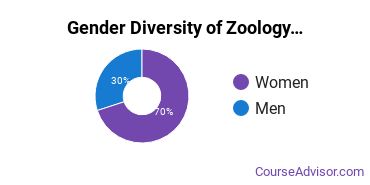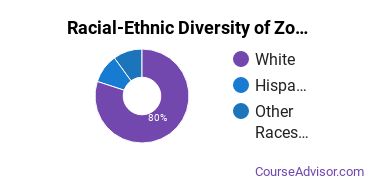Zoology at Laramie County Community College
LCCC is located in Cheyenne, Wyoming and approximately 3,838 students attend the school each year.
Want to know more about the career opportunities in this field? Check out the Careers in Zoology section at the bottom of this page.
Featured schools near , edit
LCCC Zoology Degrees Available
- Associate’s Degree in Zoology
LCCC Zoology Rankings
Zoology Student Demographics at LCCC
Take a look at the following statistics related to the make-up of the zoology majors at Laramie County Community College.
LCCC Zoology Associate’s Program

The majority of those who receive an associate's degree in zoology at LCCC are white. Around 80% fell into this category, which is below average for this degree.
The following table and chart show the race/ethnicity for students who recently graduated from Laramie County Community College with a associate's in zoology.

| Race/Ethnicity | Number of Students |
|---|---|
| Asian | 0 |
| Black or African American | 0 |
| Hispanic or Latino | 1 |
| White | 8 |
| International Students | 0 |
| Other Races/Ethnicities | 1 |
Related Majors
Careers That Zoology Grads May Go Into
A degree in zoology can lead to the following careers. Since job numbers and average salaries can vary by geographic location, we have only included the numbers for WY, the home state for Laramie County Community College.
| Occupation | Jobs in WY | Average Salary in WY |
|---|---|---|
| Zoologists and Wildlife Biologists | 310 | $62,040 |
| Natural Sciences Managers | 160 | $95,120 |
| Biological Scientists | 160 | $71,030 |
| Biological Science Professors | 110 | $79,770 |
References
*The racial-ethnic minorities count is calculated by taking the total number of students and subtracting white students, international students, and students whose race/ethnicity was unknown. This number is then divided by the total number of students at the school to obtain the racial-ethnic minorities percentage.
More about our data sources and methodologies.
Featured Schools
 Request Info
Request Info
|
Southern New Hampshire University You have goals. Southern New Hampshire University can help you get there. Whether you need a bachelor's degree to get into a career or want a master's degree to move up in your current career, SNHU has an online program for you. Find your degree from over 200 online programs. Learn More > |
